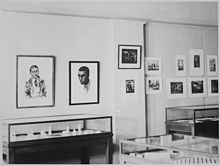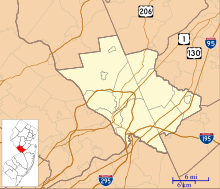New Jersey State Museum
 |
|
| Established | 1895 |
|---|---|
| Location | Trenton, New Jersey |
| Coordinates | 40°13′01″N 74°44′36″W / 40.216944°N 74.743333°W |
| Type | State Museum of New Jersey |
| Collection size | 2+ million specimens |
| Director | Margaret O'Reilly, Executive Director |
| Website | www |
The New Jersey State Museum is located at 205 West State Street in Trenton, New Jersey, United States, overlooking the Delaware River. The Museum is operated as part of the New Jersey Department of State. "Suggested" admission is $5 for adults; children 12 and under: Free; Seniors & Students with valid ID: $4; the following receive FREE general admission with valid ID: Members*, Teachers, Veterans, Active Duty Military and their families.
The Museum's main collection of specimens, artifacts and objects dates back to items collected in the early 19th century. The Museum also includes a 150-seat planetarium and a 380-seat auditorium.
The New Jersey State Museum serves a broad region between New York and Philadelphia. The Museum asks for a 'suggested' admission of just $5 per person. However, because the admission fee is 'suggested,' and programs are free or offered at a very low-cost, the Museum is accessible to visitors with low- to moderate incomes.
The New Jersey State Museum was the first state museum in the country established with education as a primary focus of its mission. The New Jersey Legislature formally established the Museum by law in 1895; the Museum received re-accreditation from the American Alliance of Museums in August 2003.
As put forth in the mission statement: The New Jersey State Museum serves the lifelong educational needs of residents and visitors through its collections, exhibitions, programs, publications, and scholarship in science, history, archaeology, and the arts. Within a broad context, the Museum explores the natural and cultural diversity of New Jersey, past and present.
In its beginning, like many museums of its era, the Museum focused on natural history. The first major collections were of rocks, minerals and fossils from the New Jersey Geological Survey, which began in 1836. In 1912, the Museum expanded its focus to include archaeology through an acquisition of artifacts produced by Native Americans in the region. These artifacts dated from the prehistoric and historic periods as well as from New Jersey's diverse populations during the Colonial and post-colonial eras. In 1922, the Museum was one of the first on the east coast to exhibit, as art, a collection of North American Indian objects. With the acquisition of these objects, the Museum started its ethnographic collections. In 1924, decorative arts were added to the Museum with examples from the Trenton-area ceramics industry. And while fine art had been exhibited and acquired through the mid-20th century, the Museum began a strong collecting emphasis on paintings, sculpture and works on paper in the early 1960s.
...
Wikipedia

